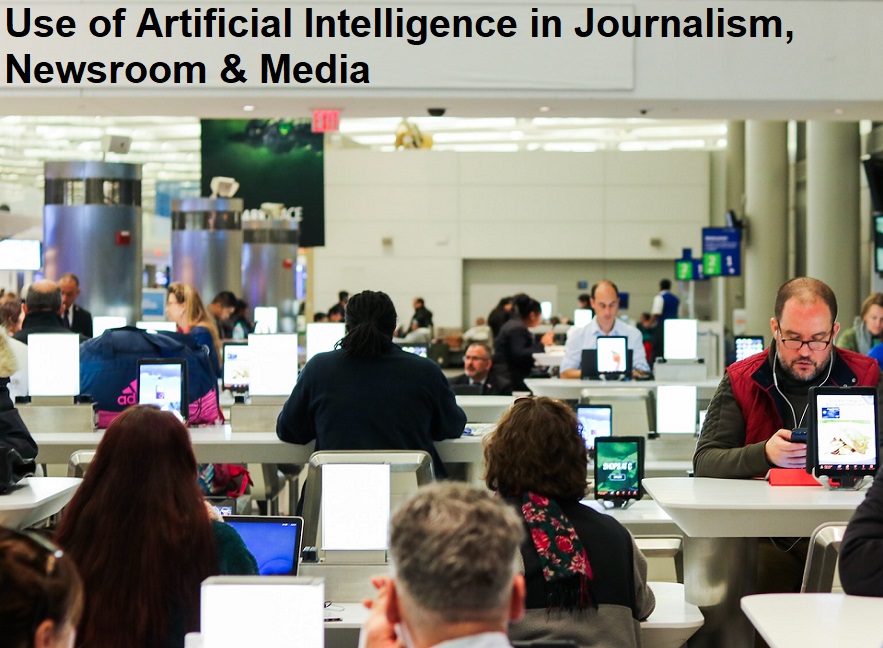Cutting-edge technology, automated cars, high-end robotics, traffic management, and editorial automation are part of what artificial intelligence (AI) offers us today. It allows us to access, process, and share millions of pieces of data at the speed of an electromagnetic wave. How does AI fit into editorial environments?
Automating does not replace; it complements and strengthens. It means speed, optimization, and precision thanks to the help of powerful big data (large banks of information) and all the learning that a machine is capable of, analyzing patterns and emulating human behavior.
5 Usage of Artificial Intelligence in Journalism, Newsroom & Media
A great ally
AI today in the editorial field is a significant contribution, as it helps journalism to be more efficient, faster, and of higher quality. Taking advantage of its benefits is vital to create more in less time, monetize content, generate news, edit texts, and develop graphics.
AI offers you, for example, Bots, which, through pre-established commands in their code, can carry out repetitive and predefined tasks such as marketing campaigns, sending newsletters, editing texts, creating graphics, sustaining a social networking platform, publishing short news items from data sources (e.g., stock market notes, weather, results, etc.), generating news in less time, generating more content in less time, monetizing content and developing graphics.
Artificial intelligence frees you as an editor to address priority topics and local issues and give depth to investigations.
Quite a few media outlets use bots to produce stories that do not require contextualization or interpretation, using tools such as Heliograf, Syllabus, Quakebot, and so on.
Examples of AI
1. Chatbots:
As if it were a human, a chatbot provides 24/7 attention to the media's readers. It chats with them to provide programmed answers to specific questions. Some of the most popular are Droz, Botmaker, and Centribal. They can also be integrated with platforms that keep a history of conversations, such as Zendesk.
2. Style and grammar checkers:
These are apps that help you write a very good note or give you term paper assistance, as they improve grammar syntax and make useful automated recommendations to improve writing. Some examples that are very well adapted to different languages are Language Tool, Hemingway, and Jasper.
3. Audio transcribers:
Otter.ai, voicegain.ai, or Notta are very advanced audio-to-text conversion tools; the transcription obtained is accurate, without a scratch, and is even capable of capturing the dialogues of a YouTube video with greater accuracy than the Google platform tool. Similarly, there are tools that take a text and create it into an audio narration, such as play.ht, Murf.ai, and voicely.net.
4. Automated journalism:
Surely, when you have seen an online advertisement, many times you have been surprised because you were thinking of using that tool. It is an example of the work of AI, which, through a coded program, records everything you do, write, or search for online. It tracks the products, graphics, notes, or services you browse and then directs you to related sites. And it's the same thing that the big media are doing today: getting to know your readers via their reading tastes, cross-referencing data, lets you know about your community and what they want to read and watch. They gain readers and subscribers through online behavior patterns. The New York Times, one of the most prestigious newspapers in the world, uses machine learning to look for patterns in the data of their subscriber acquisition campaigns and consequently optimize results.
5. Summaries:
Do you want to summarize a long book to complement an essay or a report? AI puts you within reach of the text generator GPT-3 Books, an intelligent software capable of summarizing books of any size; with certain limitations, it "highlights," prioritizes, and places the most transcendental. It is a useful tool when it comes to saving time and simplifying tasks.
6. Design:
There are several graphic design tools that use artificial intelligence to transform ideas into graphic pieces with surprising speed and precision. The AI engine analyzes the entered concept and generates hundreds of graphic design possibilities from which you can choose the best one to suit your needs. Some of them are Designs.ai, Kroma, and Adobe Sensei.
Thus, artificial intelligence has arrived in newsrooms to complement the human work of journalists, editors, writers, and graphic designers, coexisting in real-time, not only to generate competitiveness and profits but also in the same way of life and perception of readers, who demand promptness, quality, efficiency, which in turn means satisfaction and trust.








COMMENTS